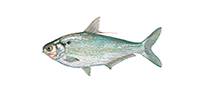Thank you for visiting the Seafood Selector. EDF is planning a new approach to providing information to consumers about good seafood choices. Please come back soon for updates.
Shad

Shad
Recommended servings per month
| Contaminant | Men | Women | Kids 6-12 | Kids 0-5 | |
|---|---|---|---|---|---|
| American Shad | Mercury | 4+ | 4+ | 4+ | 4+ |
Eco details:
- Once abundant, shad populations are at all-time lows across the Atlantic seaboard and show no signs of recovering.
- The main culprits for the decline are overfishing, pollution and habitat loss due to dam construction.
- Fishing for shad was banned in the Chesapeake Bay in 1994, and most other shad fisheries ceased in 2005.




